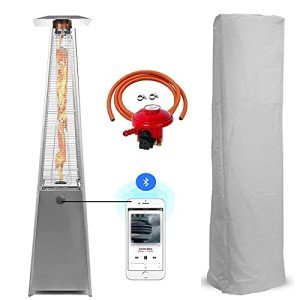20 Things You Should Be Educated About Buy Gas Radiant Heaters

Buying Gas Radiant Heaters: A Comprehensive Guide
Gas radiant heaters have actually acquired popularity over the last few years for their effectiveness and ability to provide instant warmth. As more house owners and organizations look for methods to keep their areas comfortable, understanding the functions, advantages, and considerations when purchasing these heating systems can be extremely useful. This article explores the intricacies of gas radiant heaters, aiding potential purchasers in making notified choices.
What are Gas Radiant Heaters?
Gas radiant heaters are devices that use propane or natural gas to release heat straight into a space. Instead of heating the air, they warm things and people in their vicinity, offering comfort faster and efficiently. These heaters are popular for both indoor and outdoor settings due to their flexibility and efficiency.
Key Features of Gas Radiant Heaters
- Direct Heating: Unlike standard heaters that warm the air, gas radiant heaters supply direct heat, making them an efficient choice for rapidly warming up spaces.
- Mobility: Many designs are offered as portable units, permitting them to be quickly moved from one location to another.
- Fuel Variety: Gas radiant heaters can be powered by gas or propane, offering users flexibility based on accessibility and preference.
- Adjustable Settings: Most gas radiant heaters included adjustable heat settings, allowing users to customize the level of heat based upon their requirements.
Benefits of Gas Radiant Heaters
- Energy Efficiency: These heaters transform gas into heat efficiently, leading to lower utility costs compared to electrical heaters.
- Quick Heating: Radiant heat is felt almost right away, making these heaters suitable for abrupt temperature drops.
- Low Maintenance: Gas radiant heaters normally need less maintenance than electric models, making them a hassle-free alternative.
- Ecologically Friendly: When powered by clean gas, these heaters can be a more ecologically sustainable option compared to other heating methods.
Types of Gas Radiant Heaters
When it pertains to choosing a gas radiant heater, it's important to comprehend the various types available. Below are the most typical options:
- Indoor Gas Radiant Heaters: Designed for indoor areas, these heaters are typically vented or unvented and typically included integrated safety functions.
- Outdoor Gas Radiant Heaters: Commonly used in patio areas or outdoor dining locations, these heaters are created to endure the aspects.
- Wall-Mounted Gas Radiant Heaters: A space-saving choice, these units are perfect for smaller areas and can be outfitted with various heat outputs depending on the area's requirements.
- Freestanding Gas Radiant Heaters: These portable designs can be used in different places, perfect for those who require flexibility.
Buying Guide: How to Choose the Right Gas Radiant Heater
When acquiring a gas radiant heater, several factors need to be thought about to guarantee you pick the right design for your space:
1. Heating Capacity
- Measured in BTUs (British Thermal Units), the heater's capacity identifies how much location it can efficiently warm. Purchasers need to evaluate their particular needs based on room size.
| Room Size (sq ft) | Recommended BTUs (for Gas Radiant Heaters) |
|---|---|
| 100 - 200 | 5,000 - 10,000 BTUs |
| 200 - 400 | 10,000 - 20,000 BTUs |
| 400 - 600 | 20,000 - 30,000 BTUs |
| 600 - 800 | 30,000+ BTUs |
2. Kind of Gas
- Consider whether you will be using propane or gas, as various heaters cater to different fuel types.
3. Safety Features
- Search for models equipped with security functions such as automated shut-off valves, tip-over security, and oxygen exhaustion sensors.
4. Setup Requirements
- Some heaters might need expert setup, specifically vented designs. Make certain to think about the expenses and requirements related to setup.
5. Portability
- If versatility is essential, think about portable models that can be easily moved from one location to another.
Installation and Maintenance
Gas radiant heaters are generally simple to install, particularly portable models. Nevertheless, vented Patio Heating Solutions might necessitate expert setup to guarantee they fulfill local security codes.
Maintenance generally involves:
- Regular cleaning to prevent dust buildup.
- Examining gas connections and fittings for leakages.
- Guaranteeing security functions are functional.
Suggestion: Regular checks around the system can assist extend its life-span and keep safety.
Often Asked Questions (FAQs)
Q1: Are gas radiant heaters safe for indoor use?A1: Yes
, as long as they are effectively vented and geared up with needed safety features, they can be securely utilized indoors.
Q2: Can gas radiant heaters be utilized in enclosed spaces?A2: Unvented gas heaters can posture threats in enclosed spaces due to possible suffocation or carbon monoxide buildup. Always guarantee enough ventilation. Q3: How do I know what size heater I need?A3: The proper size depends upon the area you mean to heat. Describe the BTU chart
above to determine your requirements. Q4: What is the difference in between propane and gas heaters?A4: The primary distinction depends on their energy source
; propane is delivered by means of tanks, while gas is typically piped into homes. Q5: How can I make the most of efficiency?A5: Ensure the heater is appropriately sized for your space, preserve it regularly, and consider using it in mix
with other heating methods for optimum convenience. Gas radiant heaters can be an excellent addition to any home or organization, offering energy-efficient and fast heating solutions. By comprehending the different types, features, and factors to consider
when buying, purchasers can make educated choices that fulfill their heating needs. With the ideal option, these heaters provide comfort, reliability, and a welcoming environment during cooler seasons.

